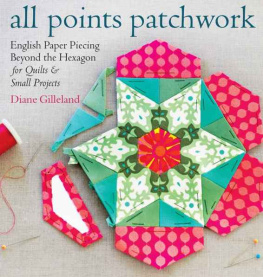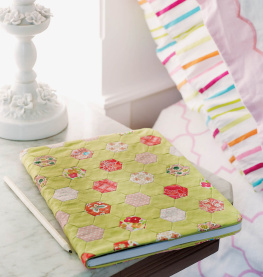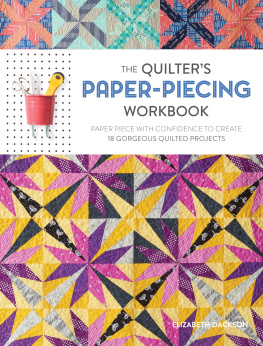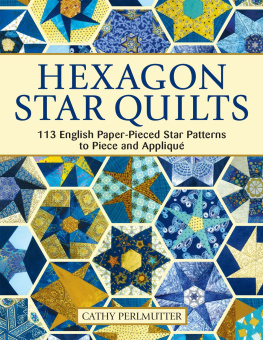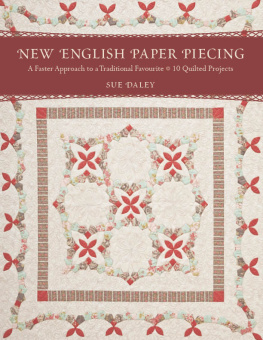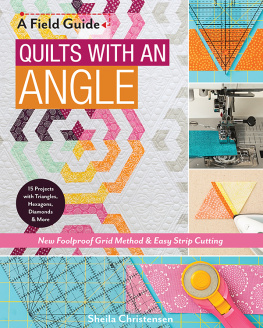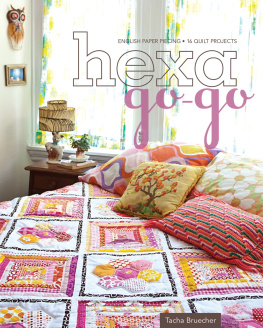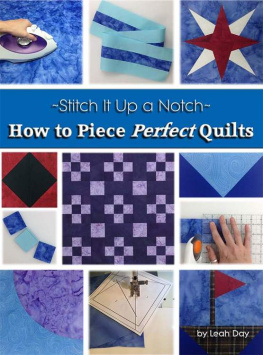for mom
Contents
Hello, EPP!
I love English paper piecing because of two conflicting traits: I adore complex-looking patchwork, but when Im piloting a sewing machine, well... Im not all that precise. I do enjoy machine sewing, but its not exactly a relaxing activity for me (getting perfectly matched points always involves a bit of stress and seam ripping). So the first time I cut out some paper hexagons and started basting fabric to them, I knew I had stumbled onto something very special a way to make amazing patchwork pictures without struggling over construction!


If youre a quilter, you might see English paper piecing (or EPP for short) as a slow and labor-intensive technique. If youre a sewist who makes garments and small projects, you might think EPP is only for quiltmaking. No matter how you sew, in this book I hope to inspire you to think about EPP differently. You can use it to make beautiful and impressive quilts, but you can also add a bit of patchwork magic to smaller projects like placemats and pillows. You can make appliqu motifs to sew to clothing and bags. You can create brilliant patchwork fabric to cut up and sew into soft toys and zippered pouches. And you can easily design your own original EPP patterns. Best of all, you can do all of this without having to be an accomplished technical sewist.
Every single time I teach EPP, I wait eagerly for the moment when one of my students looks up from his or her patchwork, face lit up with inspiration, and bursts out, Wow! This is so easy! I can use it in all kinds of ways! Those moments are what led me to write this book. I hope youll find EPP as liberating, relaxing, and, yes, as addictive as I do.
Idea Book vs. Project Book
This book differs from many other craft books in one important way. Im going to show you a lot of EPP project ideas, from quilts to soft toys to home decor to accessories, but I wont be teaching you exactly how to make any of those items.
I structured the book this way for two reasons. First, I wanted to show you as many different ways to use EPP as possible. If I were to include project instructions for all 29 project ideas and 84 pattern design ideas Im sharing here, Id end up with a weighty tome of a book, with very few pages left to explain how to actually EPP. Instead, I wanted to be able to go into as much helpful EPP detail as possible there are so many wonderful little tricks to this craft!
Second, I wanted you to have the freedom to use EPP in any way you can dream up. Sometimes, I find that being presented with specific project instructions can be somewhat limiting. If, for example, you prefer to sew pillows, and I used five pages to explain how to make a tote bag, then those pages arent all that useful for you. Not only that, but its likely you already have favorite projects youve made many times, and its so easy to incorporate EPP into these. (Youll learn how to do this in ).
Chances are, too, that you already own other books about quiltmaking or sewing books with patterns that would welcome some EPP touches. And, well, the Internet is simply teeming with free patterns and instructions. So youre more than covered for basic patterns! Lets focus instead on giving you as much EPP technique and inspiration as possible. I hope youll mix and match the ideas in this book to make something thats truly your own.
For most of the project ideas in this book, I used EPP (sewn by hand) to make the patchwork and the appliques and machine sewing for the basic construction. But theres no reason why you cant hand-sew the projects entirely. In this books website, AllPointsPatchwork.com, youll find a list of links to free online tutorials and good commercial patterns for these kinds of projects. And if theres something youd like to make but you arent sure where to begin, feel free to e-mail me at Diane@AllPointsPatchwork.com and Ill be glad to help you get started. (Id also love to see pictures of what you make!)
Speaking of getting started...
A Few Tidbits before We Begin
In this short section, well learn a little of this crafts fascinating history and cover a few basic concepts. But if youre chomping at the bit to start doing EPP, feel free to jump to and come back here later.
Where Does EPP Come From?
English paper piecing dates back to the late 1700s, when hexagon quilts became popular in England. Also called mosaic quilts, honeycomb quilts, or six-sided patchwork, they were made by a method similar to what we know today: basting fabrics over paper templates and then sewing the hexagons together by hand. Hexagon-based patterns became the most popular patchwork style in England by the 1830s, and the mania quickly spread across the pond to America, where the venerable magazine Godeys Ladys Book carried a hexagon quilt pattern for the first time in 1835. (Incidentally, at that time U.S. women considered all things British to be very elegant, which is why the technique was first called English paper piecing in the States.)

Detail of a Grandmothers Flower Garden quilt, courtesy of Lynn Kogh
The earliest hexagon quilts were one-patch affairs, using many different colors of fabric with no formal arrangement. Thrifty quiltmakers loved the technique as a way to make use of small scraps. But before long, a pattern called Grandmothers Flower Garden emerged and became extremely popular. In this pattern, the colors are arranged in flower shapes made from several rows of hexagons, with a solid garden path border of white or green running between them.
But EPP didnt stop developing with this pattern. Before long, creative sewists started arranging their hexagons into stripes, diamond forms, and more. And from there, quiltmakers started cutting their paper into triangles and diamonds as well as hexagons, and combining these shapes into even more complex EPP designs.
As home sewing machines became more common through the late 1800s, EPPs role in quiltmaking shifted. It may have seemed much more labor-intensive compared to machine sewing, but it still afforded quilters a soothing hand-sewing project to work on during evenings and quiet moments. The Grandmothers Flower Garden pattern remained popular through the 1930s and 1940s as a kind of challenge project that a quilter might work on little by little for years and then display proudly as a huge accomplishment in her creative life.

